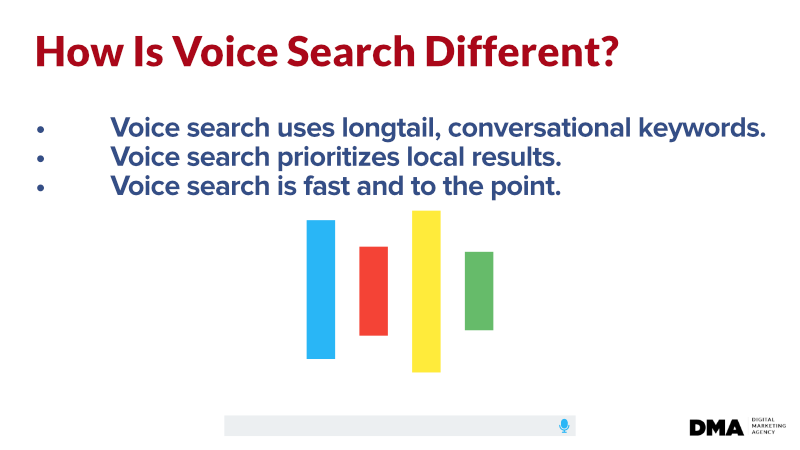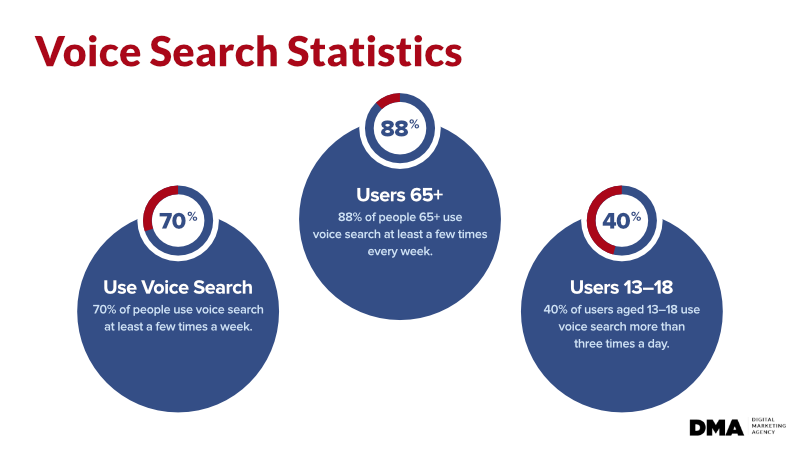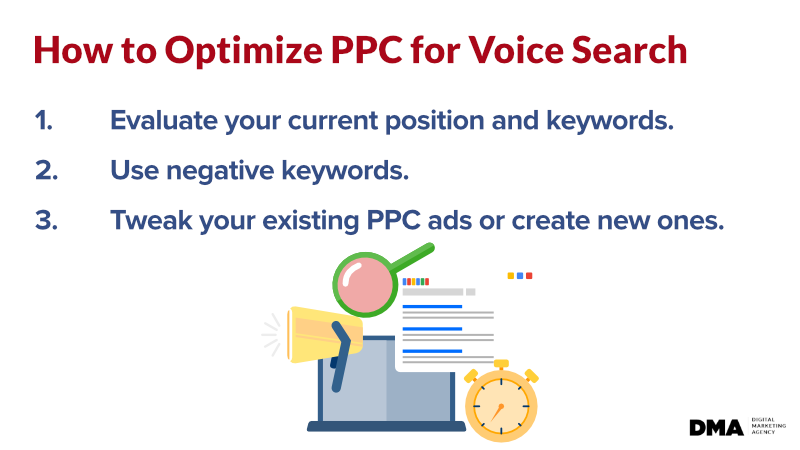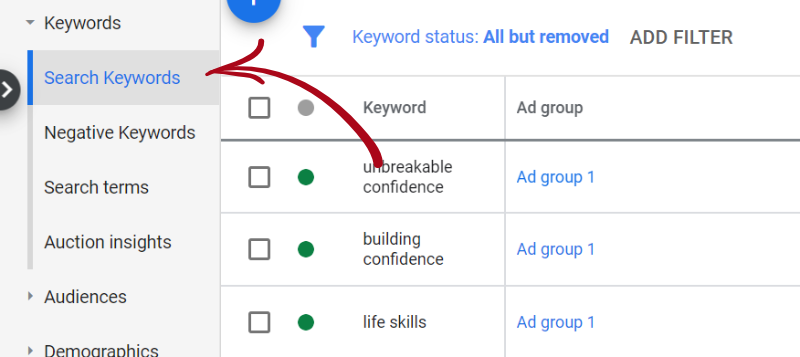SEO
Free SEO Analysis
SEO Services
Content Marketing Services
Local SEO
Link Building Services
Specialized SEO Services
PPC
REPUTATION MANAGEMENT
Free Reputation Management Analysis
Reputation Management Services
Review Management Services
Specialized Reputation Management Services
CEO Reputation Management
Brand Enhancement
Business and Directory Listings
Comprehensive Reputation Management Audit
SOCIAL MEDIA
Free Social Media Analysis
Specialized Social Services
WEB DEVELOPMENT
Free Website Analysis
Web Design Services
Mobile Development Services
Website Maintenance Services
Specialized Development Services
MARKETING AUTOMATION
Free Marketing Automation Analysis
Specialized Marketing Automation Services
Comprehensive Marketing Automation
INDUSTRIES
ABOUT DMA
SEO
Voice Search in Digital Marketing: How to Optimize Your Content and PPC
Request a quote
Its Fast, Easy & Free
Executive Summary
- Google voice searches have increased exponentially over the years as smart speakers and smartphones have become more prevalent.
- Voice search uses natural language processing (NLP) and special algorithms that have evolved to become incredibly adept at finding and providing answers to users.
- With the voice search best practices we’ve included in this article, you’ll be able to quickly optimize your content and PPC for voice search.
When do you do a voice search, like:
“Okay Google, what’s the best pizza place nearby?”
“Hey Alexa, is there a pharmacy near me?”
“Siri, what is a manatee?”
We talk to our smartphones and smart speakers multiple times a day, asking questions about our surroundings, pop culture, and everything else under the sun.
With so many people using voice search to get their questions answered, it’s only natural for marketers to wonder about voice search in digital marketing. How can you be sure that your content and PPC ads are optimized?
While voice search may not have taken over the world by 2020 as was expected, there are still some important lessons to be learned.
Smart speakers, smartphones, and virtual assistants are everywhere and they’re changing the way we consume and search for information.
And, it turns out that optimizing for voice search does wonders for your overall SEO.
In this article, we share tips you can use to optimize for voice search in digital marketing and improve your traditional search results along the way. But first...
What Is Voice Search?
Simply put, voice search uses voice recognition technology that lets people search for information on the internet by speaking to a device like a smartphone or a smart speaker.
Google voice searches have increased exponentially over the years as smart speakers and smartphones have become more prevalent.
What Does Voice Search Mean for Digital Marketing?
Voice search has gone through some changes over the years. It’s become more widely available and easy to use, but that’s not near the best of it.
Voice search uses natural language processing (NLP) and special algorithms that have evolved to become incredibly adept at finding and providing answers to users.
You already know that search engine optimization is important to digital marketing. Any business can use SEO with great results. But if you’re not optimizing for voice search, you might be missing out on rankings boosts and traffic you could otherwise grab.
And, again, optimizing for voice search involves several SEO tactics that will put you in a better position with traditional searching, too.
What’s the Difference Between Voice Search and Traditional Search?
For starters, with voice search, you speak your query. With traditional searching, you type it.
But that doesn’t even scratch the surface.

Let’s take a look at three key differences between voice search and traditional search.
Voice Search Uses Longtail, Conversational Keywords
When we ask a smart device a question, we typically ask the entire question, meaning we follow natural speech patterns.
So, in a traditional search, you might type “pharmacy near me,” but for a voice search you’d say, “Okay Google, where’s the nearest pharmacy?”
We tend to type only specific words for a traditional search, but with voice searches, we ask the entire question, just as we would ask another person.
Voice Search Prioritizes Local Results
While you can use voice search to ask questions about anything, people tend to use it to find businesses that are near their current location.
Voice Search Is Fast and to the Point
Voice search typically uses content from featured snippets for search results. So, instead of reading through a few results to find the information you want, you can just sit back and listen to your smart device tell you all about manatees or whatever else you’ve searched for.
Then, if there’s more information, you’ll be asked if you want to go to the site.
The purpose of voice search is to give you a direct answer to your question so you don’t have to do anything else, but you can if you want.
How do People Use Voice Search?
Search Engine Journal wanted to understand how people are really using voice search, so they conducted a survey of 620 respondents between the ages of 13–85 in the U.S., India, Europe, Canada, and other countries. The respondents generally considered themselves to be at least somewhat tech-savvy.
They found that a majority of survey respondents had incorporated voice search into their daily lives, with 70% of respondents using voice search at least a few times a week. More than a quarter (27%) of respondents said they use voice search multiple times a day.

Interestingly, the age group that uses voice search the most is the oldest—65+. 88% of that age group said they use voice search at least a few times every week. This is good information for companies that market to this group.
Strangely, usage dropped dramatically for the second-oldest age group (55–64). This age group had the lowest voice search adoption rate.
The youngest group of respondents, those aged between 13–18, are the second biggest users of voice search, using voice search at least a few times a month. And, 40% of this age group say they use voice search more than three times a day.
Based on this information, it’s likely that voice search will increase in popularity with future generations.
So, where are people using voice search? Primarily at home or in the office (42%). About 30% of respondents rely on voice search when they’re out and about.
More than half (56%) of respondents said they prefer using voice search on their mobile devices rather than a smart speaker (30%). This indicates that access to voice-enabled devices could present a barrier to adoption and users prefer having voice search capabilities built into devices they already have (like smartphones).
Voice search has a huge reach and high adoption. This is a trend that’s only going to continue as the internet becomes more saturated with content that searchers don’t want to sift through to find a quick answer.
How to Optimize for Voice Search in Digital Marketing
In this section, we’ll show you how to optimize your content marketing and PPC campaigns for voice search.
Content Marketing
Even though voice search hasn’t caught on the way people thought it would, there’s every indication that adoption will continue to rise.
The good news is that you can optimize your content for voice search without hurting your traditional search rankings.
In fact, taking the time to make your content more friendly to voice search will help you create better, more in-depth, and conversational content—all things that will help your traditional search rankings.

Here are some voice search optimization tactics to use.
1. Optimize for Featured Snippets and Rich Answers
SEMrush conducted a voice search study and found that 70% of all answers returned using voice searches had a SERP (search engine results page) feature, with 60% of the voice search results using a featured snippet result.
Optimizing for featured snippets and rich answers that include knowledge panels and knowledge boxes is a great way to get your content ready for voice search.
2. Restructure Your Content
Voice search is conversational. When optimizing your content for voice search, you’ll want to write conversationally and actually use questions and answers within your content.
In a Backlinko study, they found that Google gives preference to short, succinct answers to voice searches. The average voice search result is only 29 words long. SEMrush found that the average response length across devices came to about 41 words.
We recommend updating your content to include FAQs (in both pages and blog articles). FAQs are packed with question keywords and typically have short responses that thoroughly answer the question. This makes it really easy for Google to pull that content from your website.
Not sure about the value of FAQs? Here’s how we helped one of our clients increase organic traffic by 588% YoY by implementing FAQPage schema.
3. Write Conversationally
A lot of optimizing for voice search is simply writing more conversationally and using natural language.
Of course, it’s important to understand your audience before you settle on your “voice.” Who are you writing content for? What questions keywords are they using? How do they speak to their friends?
4. Improve Your Site’s Speed
When your website takes too much time (more than 3 seconds) to load, you’re going to lose visitors. Plus, your rankings are going to tank.
Voice searches are no different.
If you have a slow website, your content simply won’t be used.
Here are a few ways to reduce your load time:
Compress your images and videos (and use fewer of them)
Use CSS3 and HTML5 frameworks
Minify your CSS and JavaScript
Use a CDN (Content Delivery Network)
For more information, check out this article with ways to improve your site speed.
5. Use Google My Business and Local SEO
To improve your chances of being included in “near me” searches for voice, start by optimizing your Google My Business (GMB) listing.
A Google My Business listing lets Google know where your business is located. If your GMB listing is optimized, your business could rank for local searches related to your products and services.
At a minimum, include your name, address, and phone number (this is referred to as “NAP”). But, it’s also important to add the best business categories and to add images, posts, and updates to your GMB page to ensure that your business stands out from the competition.
There are many other ways to improve your local SEO. Check out this article with local SEO tips to boost your local search rankings for voice and traditional searches.
6. Improve Your Readability
If your content is hard to read, it’s not going to rank well. Searchers want clear, readably content that answers their questions and doesn’t take long to read and digest.
Voice search is the same.
If you’re using buzzwords and jargon instead of simple, easy to understand language, your content isn’t going to rank well and it’s not going to be used in voice search.
PPC Advertising
When you’re optimizing for voice search, don’t forget your PPC advertising campaigns!

In this section, we’re going to talk about three ways you can use voice search in digital marketing to get your ads noticed.
1. Evaluate Your Current Position
Before you make any changes, you’ll want to take stock of how your current keywords are performing and how people are finding you right now.
If you’re using Google Ads, you can find the search terms that people use to see your ad by opening up one of your campaigns and click on Keywords > Search Keywords.

Typically, voice searches use longtail keywords (4–6 words), so look for those as well as searches that begin with voice search markers (“okay google,” “alexa,” “hey siri,” “when does,” etc).
What can you learn from this information? A lot, actually.
For starters, if you have a lot of searches starting with “okay google,” you’re getting a lot of mileage from your Google rankings. But, if you’re seeing “alexa” pop up, you may want to consider spending some ad dollars on Microsoft Advertising since Alexa uses Bing.
2. Use Negative Keywords
If you’re finding search terms that you don’t want people to use to find your ad, adding negative keywords will make that happen.
Just don’t add negative keywords that include voice search keywords. So, no adding negative keywords referencing when or where questions or voice search tools like “ok google” or “alexa.”
3. Tweak Existing PPC Campaigns or Create New Ones
Once you’ve found out how people are finding your PPC ads, you can use that information to create a list of keywords that will better serve you for voice searches.
This could require making changes to your existing PPC campaigns or creating new ones altogether in order to optimize for voice search.
When you’re compiling a new list of voice search optimized keywords, remember to include search terms along all stages of the customer journey.
Pay particular attention to keywords using the four Ws: Who, What, When, and Where. This will help you understand where your customers are in the customer journey as well as help you figure out which longtail keywords you want to include.
Conclusion
Voice search in digital marketing relies on succinct, in-depth, well-formatted content that uses the natural language you’re more likely to find in face-to-face marketing.
With the voice search best practices we’ve included in this article, you’ll be able to quickly optimize your content and PPC for voice search. Since more than 70% of marketers say they aren’t going to make any changes for it, this will put you ahead of the curve for adoption.
And this means your brand will be in a much better position as more and more people use voice search.
Think you don’t have the time to get your content and PPC ads into voice search shape? Digital Marketing Agency is here for you!
We offer SEO services from award-winning SEO experts with a proven track record of creating SEO campaigns that take advantage of powerful resources, establishing our clients' websites as authorities in their industry. Contact us today for a free quote.
Our Sales team